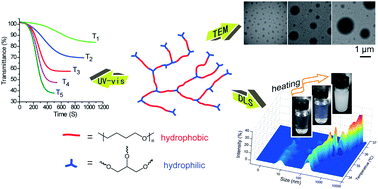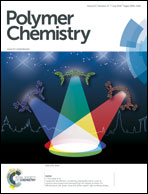Phase transition dynamics and mechanism for backbone-thermoresponsive hyperbranched polyethers†
Abstract
In this study, a controllable thermo-induced phase transition process was first observed in the aqueous solution of backbone-thermoresponsive hyperbranched polyethers. According to the variable temperature UV-visible spectrophotometry, the phase transition process was extremely slow as temperature was set around lower critical solution temperature (LCST). Fluorescence tests showed that this slow phase transition behavior was related to the gradual thermally-induced dehydration of hyperbranched polyethers. Based on this unique behavior, the dynamics of phase transition was conveniently investigated by the temperature-jump method. Results showed that the dynamics of phase transition can be described by single exponential functions, and the dynamic parameters depended on temperature. Dynamic laser scattering and transmission electron microscopy revealed that the hyperbranched polyether self-assembled into micelles below its LCST, while the temperature-dependent aggregation occurred and complex micelles with larger size formed above LCST. Furthermore, the gradual aggregation process was in accordance with the rate-limited colloidal aggregation mechanism. Our research can contribute to the clarification of the dynamics and mechanism of this typical gradual phase transition process of backbone-thermoresponsive hyperbranched polymers, as well as their self-assembly and aggregation mechanisms.


 Please wait while we load your content...
Please wait while we load your content...